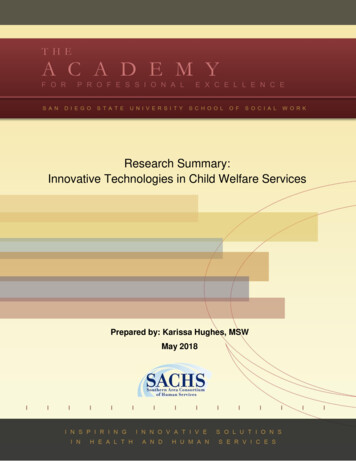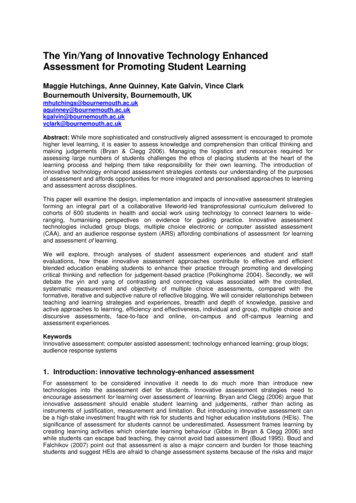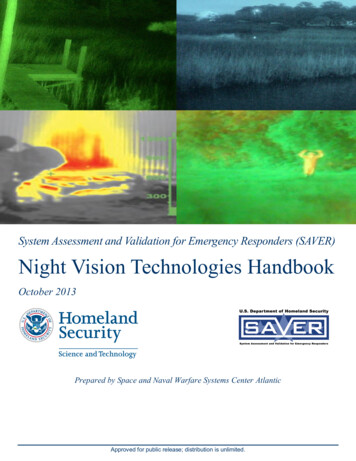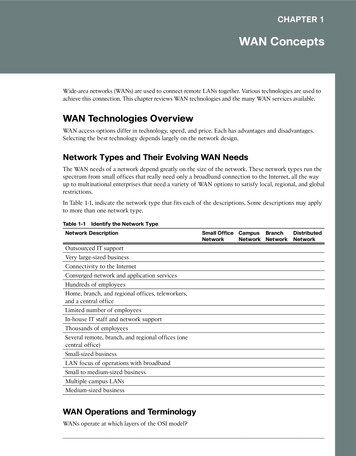
Transcription
Research Summary:Innovative Technologies in Child Welfare ServicesPrepared by: Karissa Hughes, MSWMay 2018LeadersPage 1inAction–EvaluationReport–August2016
SACHS Research Summary: Innovative Technologies in Child Welfare Services (May 2018)TABLE OF CONTENTSExecutive Summary . 2Background . 3Cloud/Web-Based Information Systems and Case Management Tools . 4Mobile Technologies . 6Horizontal Integration and Interagency Data-Sharing . 12Use of Technology by Foster Youth . 15Social Media. 17Use of Technology in Foster Parent Recruitment and Retention . 23Predictive Analytics . 28Other Emerging Technologies for Child Welfare Agencies . 31Additional Resources . 36References . 39Appendix A: Summary of Highlights-SACHS Counties Technology Innovations . 46Appendix B: Types of Mobile Apps for Foster Parents . 50Appendix C: Five Lessons for Implementing Predictive Analytics in Child Welfare . 511
SACHS Research Summary: Innovative Technologies in Child Welfare Services (May 2018)Executive SummaryTo meet the unique needs of children and youth in the child welfare system and better coordinatetheir care, several provider organizations are turning to technology. There are many innovative technologiesemerging that may improve services and outcomes for this special population. At the request of the SouthernArea Consortium of Human Services (SACHS), this research summary provides information on how theseavailable or evolving technologies are impacting child welfare services as well as examples from otherjurisdictions who are effectively leading the use of technology and innovation efforts in their child welfareagencies.This report highlights the use of cloud/web-based information systems and case management tools,mobile technologies in the field (including mobile applications), interagency data-sharing anddata-integration efforts, social media platforms, the incorporation of technology into foster parentrecruitment and retention efforts, and data/information mining to aid in the application of predictive analyticsto inform child welfare practice. In addition, this report provides a brief overview of a variety of otheremerging technologies that may be beneficial for child welfare agencies including: data visualizationsoftware, document management systems, Internet of Things (IoT), location-based services/geofencing,business rules engines (BREs), blockchain and intelligent automation technologies, conversational artificialintelligence platforms, and virtual reality.Most of the technologies described in this report will require transformative changes to agenciesincluding their systems, policies and procedures, program design and implementation, casework practice andprotocols, and staff training/workforce development plans. In addition, as new technologies develop, childwelfare workers will experience distinct benefits and challenges related to the use of these technologiesdirectly or indirectly with their clients. “As social work practice and technology continue to become moreintegrated, there will be a greater need for more research on the impact of these technologies, as well as howchild welfare staff and agencies can ethically and effectively manage emerging challenges” (Breyette, 2014).The report concludes with a selection of supplemental resources that provide further informationabout technology development and use in the child welfare field, including implementation guidance.2
SACHS Research Summary: Innovative Technologies in Child Welfare Services (May 2018)BackgroundHuman service agencies strive to innovate and explore how their services can more effectively improveoutcomes for individuals, children, families and communities. The complexities of this cross-programmaticand cross-sector system of care have presented obstacles to the human service field’s ability to modernizeand keep pace with other industries, such as healthcare. Across the nation, the capacity of child welfareagencies to deliver services to vulnerable children, youth and families while relying on aging informationtechnology (IT) systems has been a barrier. Fortunately, recent changes to regulations and funding by theU.S. Department of Health and Human Services (HHS) opens doors to new opportunities for activelyintegrating innovative technologies into child welfare agencies across the country.Comprehensive Child Welfare Information Systems (CCWIS) Final RuleFor the first time in decades, to modernize the aging child welfare information systems the U.S. Departmentof HHS Administration for Children & Families (ACF) issued its highly anticipated Comprehensive ChildWelfare Information System (CCWIS) final rule on June 2, 2016. This final rule includes new regulations toguide the use of technology in child welfare. It promotes leveraging technology for innovation and agility toaddress issues in child welfare services. The final rule removes the requirement for a single comprehensive system and allows Title IV-Eagencies to implement integrated solutions such as Commercial-Off-The-Shelf (COTS) products thatcan better support current child welfare practices. This new approach is exciting and offers an arrayof possibilities for the child welfare business model and the solutions designed to support it.o The CCWIS regulations allow state and county child welfare agencies to use more effectivetechnologies to quickly identify youth and family needs and link them to services. CCWISstructures are distinguished from the legacy Statewide Automated Child Welfare InformationSystem (SACWIS) by being smaller, more modular, and designed for interoperability. When the past SACWIS were implemented, child welfare agencies went through alengthy design period, which required them to identify all their IT systemrequirements upfront and then build a massive system, test it, fix the bugs, and put itinto production. This meant workers were often forced to wait years before theycould take advantage of a new system. In addition, these systems were not designedto account for new requirements, making them inflexible and costly to update. Child welfare agencies can now also explore opportunities to take advantage of othercapabilities via CCWIS that are not common in older SACWIS systems such asconfigurable case management and associated workflows, mobile computing,predictive analytics, automated assessments, worker optimization tools, and modernmarketing and recruitment capabilities—which have the potential to improve caseworkers’ efficiency and the outcomes for children involved with foster care.o The final rule regulations also promote the exchange of information between child welfareagencies and contributing organizations such as schools, courts, and other health and humanservices departments, while giving agencies the flexibility to build systems that are tailored tomeet their unique needs to better serve young people in and aging out of care.U.S. Department of HHS New Partnership to Build Technology Systems The U.S. Department of HHS ACF teamed up with the General Services Administration's (GSA)Office of Citizen Services and Innovative Technologies to provide one million dollars of consultingservices to states as they procure agile child welfare data systems.3
SACHS Research Summary: Innovative Technologies in Child Welfare Services (May 2018)o Through this new partnership, GSA provides in-depth training and assistance on modularprocurements, user-centered design, agile development, application programming interfacesand open source technologies for child welfare agencies nationally (Barack Obama, 2016).U.S. Department of Labor, Office of Safety and Health Administration In 2016, the U.S. Department of Labor, Office of Safety and Health Administration recommended the useand support of technology in the high-risk health care and social service sectors to prevent workplaceviolence and increase efficiencies, including provision of paging systems, global positioning system(GPS) tracking, and mobile phones.White House Foster Care and Technology Hackathon In May 2016, the White House, the U.S. Department of HHS, and Think of Us jointly hosted a WhiteHouse foster care and technology hackathon. This two-day event brought together child welfareprofessionals, attorneys, foster care families and alumni, and technologists and engineers to identifyand develop “21st century solutions” (e.g. using computer technology) to solve problems facingchildren, families and professionals in the child welfare system (Barack Obama, 2016).o The initial White House Foster Care and Technology Hackathon held in Washington D.C.has sparked follow-up with locally-based Foster Care and Technology Hackathons takingplace in other jurisdictions, so far this includes Mountain View, New York, and Los Angeles.Cloud/Web-Based Information Systems and Case Management ToolsSACWIS/CCWIS As stated prior, the U.S. Department of Health and Human Services, Administration on Children,Youth and Families (ACF) Children’s Bureau provided states with increased flexibility andencouraged child welfare agencies to examine how modern technologies and interagency datasharing could improve their efforts with the issuance of its CCWIS Final Rule in 2016.o The Children’s Bureau tracks current child welfare information systems or projects in thestates and tribes. As they move from older SACWIS systems publicly available Children’sBureau tables show the Current Child Welfare Information System (CCWIS) status (i.e. indevelopment or operational) of each state’s system or project during the CCWIS transitionperiod (August 1, 2016, through July 31, 2018). These tables can be found tus As of April 18, 2018, a total of 19 states (including DC and territories) and tribeshave declared a CCWIS. One of the first states to do so, Indiana implemented a cloud-based, fully mobile child welfareinformation system and case management platform in 2012 in partnership with Annie E. CaseyFoundation and Case Commons (NCSL, 2015; Annie E. Casey Foundation, 2015).o The Management Gateway for Indiana’s Kids (MaGIK) is based on a Case CommonsCasebook core platform. It delivers an integrated, data-driven system that allows workers tosee information in real time, and allows multiple providers to submit information.o It also has embedded metrics (Goldsmith, 2015) that have resulted in practice improvements. According to Annie E. Casey Foundation (2015), embedding a face-to-face contactmetric and prominently displaying it resulted in a 13.8 percent increase in face-toface contacts over a 30-day period (Capacity Building Center for the States, 2017).4
SACHS Research Summary: Innovative Technologies in Child Welfare Services (May 2018) In addition, after implementation of its care management system (ClientTrack) inIndiana’s Department of Child Services, there was a reduction in the percentage ofstays in foster care that last under 15 days from 13.9 percent to 4.9 percent. This is animportant indicator that foster care is being used only when absolutely necessary, asbetter alternatives are being utilized for children (Noveck, 2014).Colorado is also in the process of implementing a new CCWIS system in partnership with CGIGroup Inc. According to CGI Group Inc. (2017), the CCWIS-compliant system will be mobilefriendly and will incorporate cameras and GPS capabilities.The Quality Improvement Center for Workforce Development (QIC-WD) is examining majorchanges in technology available to frontline workers in Virginia’s Department of SocialServices. They will be learning from their workers as the state rolls out mobile technology as part ofa CCWIS-related technology overhaul. They are implementing a state-of-the-art live transcriptionservice for documentation in late 2018, and later in the project, they will implement an app thatworkers can access on mobile devices.In efforts to redesign California’s case management system, Child Welfare Digital Services (CWDS)announced in December 2017, Child Welfare Services-California Automated Response andEngagement System (CWS-CARES) is the new system under development to replace the legacyChild Welfare System (CWS/CMS). The CWS-CARES implementation team is working with Stateand county organizations, including the California Welfare Directors Association (CWDA) on the15-month window of project releases, which started in July 2017 and will end September 2018.A Project Roadmap details digital service functionality roll-out dates for intake, CALS (Licensing)and case management.o Child Welfare History Snapshot: The first statewide digital service tool developed as a partof the CWS-CARES Project Roadmap is the Child Welfare History Snapshot. Snapshot is thebyproduct of months of collaboration between state offices. For the first time, the toolenables system-to-system communication between the state’s Child Welfare Services and itsCenters for Medicare & Medicaid Services (CMS). Snapshot gives social workers a Google-like search bar that allows them to searchCWS/CMS data for people (can easily search by a person’s name, date of birth orsocial security number) and their past child welfare history (including referrals andcases) all in a fraction of the time that it takes in CWS/CMS. Each search condensesinformation into a summary “snapshot,” a profile card that includes contactinformation, demographics and a person's connection to cases. Staff can also take search results and quickly copy and paste the information intoreports, child referral forms, investigation narratives or other documentation. Snapshot is scheduled to go live in early 2019. A demonstration of the Snapshot toolis available here.o All Child Welfare Digital Services (CWDS) implementation related information anddocuments can be found here: mplementation-PortalSeveral states use a web-based system for storing and analyzing SACWIS administrative data. Theseinclude California’s Child Welfare Dynamic Report System, which was jointly developed withthe University of California at Berkeley; the Results Oriented Management (ROM) Systems,developed by the University of Kansas’ School of Social Work and used by several states, including5
SACHS Research Summary: Innovative Technologies in Child Welfare Services (May 2018)Colorado and Oregon; Texas’ Data Enhanced Online Management Support (DEMOS); andUtah’s Online Analytic Processing (OLAP) (Capacity Center for the States, 2017; Fluke, 2011).The Interstate Compact on the Placement of Children (ICPC) System The American Public Human Services Association manages the National Electronic InterstateCompact Enterprise (NEICE), a cloud-based system designed to support the Interstate Compact onthe Placement of Children (ICPC) administration. Originally piloted by six states, as of 2017 therewere 22 states that signed a memorandum of understanding (MOU) to join the system (AmericanPublic Human Services Association, 2017).o For more information (including evaluation findings, costs, and technical and documentationrequirements) refer to: https://aphsa.org/OE/AAICPC/NEICE.aspxChild Maltreatment Online Reporting Systems Arizona, Delaware, Georgia, Kansas, Kentucky, Missouri, Pennsylvania, and Texas have onlineportals for receiving child abuse and neglect reports (Capacity Building Center for the States, 2017).o Websites for Arizona, Kentucky, Missouri, and Texas specify that the portal is for reportingnon-emergency child abuse and neglect.o Georgia’s portal is accessible to mandated reporters after they complete a free training andreceive an access code; users log in with a user ID and password.o Users of Missouri’s and Pennsylvania’s portals also need to set up an account and log-in witha user ID and password.o In Texas, users can set up an account or report as a “guest” user.o Kansas’ website states that its portal is for mandated reporters only, although it is openlyaccessible.Mobile TechnologiesChild welfare agencies are exploring how mobile tools can help their clients understand, access, use andmaintain their benefits. Mobile devices, such as smartphones, tablets and laptops, also offer new ways tosupport the child welfare workforce. These platforms can improve timeliness and accuracy ofdocumentation, as well as ensure access to critical information while in the field. Some agencies are startingwith optimizing their client portals for tablets. Others have developed or are exploring mobile apps as othersare looking for ways to incorporate mobile tools into their workflow (Shaw et al, 2015; National ChildWelfare Workforce Institute, 2018).Mobile Systems/Devices in the Field Quinn et al (2015) surveyed 40 social workers using video assisted visitation (VAV) as part offamily reunification efforts. Study identified the following perceived advantages and disadvantages:o The advantages included connecting to the team, relationship maintenance, therapeutic value,access due to distance, and the added visual component.o The disadvantages included the technology, age of the child, limitations of not being inperson, and fear VAV would replace in-person visits. Children’s Services in Alaska has partnered with the University of Alaska Anchorage to develop atraining and guidance program that includes a regularly updated mobile app and Facebook page(Strengthening Families Alaska, 2016; University of Alaska Anchorage, Child Welfare Academy,n.d.).6
SACHS Research Summary: Innovative Technologies in Child Welfare Services (May 2018) The Arizona Department of Child Safety (DCS) is the recipient of the 2018 CIO 100 (this is anannual award program that recognizes organizations around the world that exemplify the highestlevel of operational and strategic excellence in information technology) for implementing mobiletechnology innovations into its case management system. DCS uses Diona solutions, with its healthand human services specific enterprise mobility for caseworkers, clients and service providers.o Arizona DCS had been operating on a legacy SACWIS which limited caseworker efficiencyand productivity in engaging with children and families. DCS took an innovative approach todigital transformation by deploying a modular, "mobile first" strategy to implementing thenew CCWIS requirements. To extend the capabilities of the system, DCS also implementedDiona Mobile Visits and Diona Mobile Investigations. Utilizing mobile devices, 1,400 DCS caseworkers can now receive and deliverreal-time data-anywhere, anytime, whether online or offline-through a governmentcloud-based, secure, scalable, and reliable platform without the need for paper files. By enabling DCS caseworkers to adopt transformative mobile technology into theirpractice, workers now can engage more productively with children and families in thefield, paper-based processes are obsolete, and client data is stored securely. "We did not want technology to become a barrier for child welfare," said DCS ChiefInformation Officer Linda Jewell. "We wanted a technology that could transformhow caseworkers operate in the field. We wanted them to devote more timeaddressing the needs of children and families, instead of filling out paperwork. That'swhy we developed these innovative solutions for our frontline workers.” With this innovative strategy, DCS is projected to save 18.7 million annually indepartmental costs and has: Boosted field access to its information system to 100 percent Improved caseworker efficiency by 20 percent Increased caseworker time spent with children and families Enhanced service quality and case outcomes Improved the quality of all data collected (Diona, 2018)Florida has a mobile iSACWIS system, developed by Our Kids, a Florida nonprofit, which works onlaptops and smartphones (Schneider & Evans, 2011). When Our Kids launched the system in 2008, italso provided agency caseworkers with smartphones equipped with GPS technology, cameras, andcase data. With the smartphones, the workers can supplement home visit notes with photos that aresent securely to the statewide SACWIS system (Allegra & Smith, 2011).Indiana has been at the forefront of child welfare technology innovations. In the late 2000s, itprovided child welfare workers with IBM ThinkPads, and replaced them with iPhones around 2013.In 2014, the state child welfare agency piloted giving workers iPads (Goldsmith, 2015).New York City’s Administration for Children’s Services announced a plan in 2017 to provide itsfrontline workers with mobile phones equipped with an app and special device to alert police if theworker feels unsafe (Durkin & Fanelli, 2017).One Oregon Department of Human Services district, in partnership with the local coordinated careorganization, provided all child welfare field workers with Microsoft Surface Pro tablets in 2017 aspart of a pilot to promote increased efficiencies and to increase health care service coordinationthrough joint use of cloud-based care coordination software.7
SACHS Research Summary: Innovative Technologies in Child Welfare Services (May 2018)Academy for Professional Excellence and SACHS Counties Mobile Applications (Apps)/Technology for CWS Academy for Professional Excellence Child Welfare Mobile Applications: Currently offers 11mobile apps focused on child welfare related topics that workers can reference to support them in thefield. New relevant apps are also in development.o Mobile apps include: After 18, Basic Interviewing, Child Development Milestones, CSECEngaging Foster Youth, Comprehensive Assessment Tool's (CAT) Tools and Definitions,Safety Organized Practice (SOP) Tool, Definiciones basicas de Recursos de SeguridadOrganizada (SOP), Elements of Sexual Abuse, Indian Child Welfare Act (ICWA), Keys toEngagement, CA Welfare and Institutions Codes for Child Welfare Services.o For a description of each app and to download (free) ols/ Los Angeles County Department of Children and Family Services (LA DCFS) Mobile ClientPortal: The Mobile Client Portal (MCP) is a mobile web application developed to provide DCFSChildren’s Social Workers (CSWs) easy, safe, and secure access to children’s records regardless oflocation –whether in the office, or in the field conducting a family visit or an investigation. The MCPapplication gives workers the flexibility to be more productive and efficient, allowing for more timeto be spent with clients to ensure and improve child safety, permanency, and service.The MCP application has the following key features:o Allows upload of client photos to the Department’s KidPix photo collection;o Allows upload of photos of homes, and living conditions;o Allows a request for a criminal background check, made for caregivers through the CaliforniaLaw Enforcement Telecommunications System (CLETS);o Allows workers to access client caseload information;o Captures interview notes using Siri (Apple’s intelligent personal assistant);o Provides voice-guided Global Positioning System (GPS) navigation to and from clientlocations;o Enables electronic completion and signing of departmental forms;o Allows workers to confirm, cancel, stop or check on placement requests;o Allows workers to create and submit Drug and Alcohol test referrals;o Allows workers access to ESCARS (Electronic Suspected Child Abuse Report System) toadd comments and view statuses;o Allows workers to view court hearings - minute orders;o Provides alert messages to workers if medical and dental exams are past due; ando Provides workers with child placement location information.The MCP application is device independent and can be accessed from smartphones, tablets, anddesktop computers. The MCP application is available to all case carrying workers and supervisors,such as: Children Social Worker (CSW), Supervising Children Social Worker (SCSW), ChildrenService Administrator (CSA), and Public Health Nurse (PHN). Also, the KidPix module of theapplication is available to the Human Services Aide (HSAs). Los Angeles County DCFS Visitation Scheduling Application: Currently, LA DCFS is movingforward with the development of an application to assist with visitation scheduling to make familyvisitation process more efficient for kids and parents (Loudenback, 2018; Zarate, 2017).o They will use high-tech mapping with the intent to improve court-ordered visitations for the18,000 children placed in the county’s foster care system. Idea emerged from a local hackathon (#HackFosterCareLA) in April 20178
SACHS Research Summary: Innovative Technologies in Child Welfare Services (May 2018) According to DCFS, the county spends about two million hours each yearcoordinating more than four million hours of visits.Helping children in foster care maintain relationships with their biological familieshas been linked to a greater likelihood of a child’s being reunified with family.To help optimize the ability of DCFS to provide visitations for children geospatialanalysis of the locations of children, caregivers and visitation centers will occur. Thatinformation will be included in a new app for the agency that will help reduce theamount of time parents and children spend in transit for visitation.Los Angeles County DCFS has contracted with child welfare think tank Chapin Hallto provide technical assistance. DCFS will also work with tech consulting firmSideBench to develop an in-house app for social workers and human services aides,the staff members who are charged with arranging transportation of children in care.The department’s plan also includes deploying about 20 staff members as “air-trafficcontrollers” to coordinate the court-ordered visits in many DCFS offices that serve asvisitation centers. Orange County Intervention Management System (OCIMS): OCIMS tracks pertinentinformation related to Wraparound services provided by the Orange County Social Services Agency,Probation agency, and Health Care Agency, and various Care Coordinating agencies. It tracks allreferrals, interventions and collaboration among Wraparound agencies, Care Coordinators, YouthPartners, Parent Partners, and Wraparound families to help children and their families through theirplan of care and access to mental health, educational and social services. Please refer to Appendix A: Summary of Highlights: SACHS Counties Technology Innovations(December 2016) and SACHS Counties: Mobile Applications List (May 2018) for additional mobiletechnologies/mobile apps being utilized by SACHS counties child welfare workers.Examples of Mobile Technology for Child Welfare Case Management CareDirector Connect: Provides full case management capability securely in the field on anyWindows, IOS or Android device. Mobile devices can work online and offline to prepare caseworkers for client visits, investigations in the field, and provide a secure and efficient way to conductassessments and fill out forms. Offers: case management (view clients, cases, alerts, appointmentsand relationships), forms management, risk and safety assessment, maps and GPS, uploading ofphotos and electronic signature capability, offline capability, modular and interoperable and voice totext capabilities.o CareDirector Connect can integrate with an agency’s existing health and human servicesystem or it can be part of an entirely new technology modernization initiative as agenciesreplace old systems with CareDirector’s comprehensive platform.o Studies on CareDirector in the UK and Ireland shows promise as an effective platform. CaseAide Scholar: Aims to help improve case management skills by educating and trainingprofessionals via simulation. Offers: document management, client management, standardorganization, and smart features.o CaseAide Note: A time saving user-defined mobile keyboard allowing caseworkers todocument routine tasks effortlessly. Benefits: save time documenting notes, increaseproductivity with note completion; simplify workflow checklists; provides snippets for reusable text, small or large; type, save, and use a snippet limitlessly afterward.9
SACHS Research Summary: Innovative Technologies in Child Welfare Services (May 2018) CaseWorthy, Inc.: Offers an outcomes-focused, organization-wide, advanced case managementsoftware solution for Health and Human Services (HHS) that automates and simplifies the datamanagement and funder compliance process so agencies can prove their evidence of social impact inthe communities they
One of the first states to do so, Indiana implemented a cloud-based, fully mobile child welfare information system and case management platform in 2012 in partnership with Annie E. Casey Foundation and Case Commons (NCSL, 2015; Annie E. Casey Foundation, 2015). o The Management Gateway for Indiana's Kids (MaGIK) is based on a Case Commons











